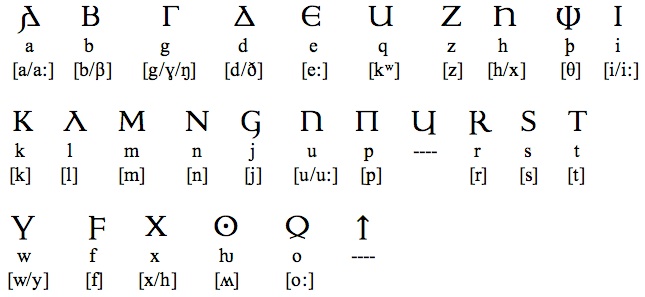An insatiable appetite for ancient and modern tongues


Classification: Indo-European, Germanic, East Germanic.
Overview. Gothic was spoken by the Goths who, leaving their homeland in Scandinavia, migrated around 200 CE to Eastern Europe, and after the fall of the Roman Empire to France, Spain and Italy. Gothic is known almost exclusively by a translation of the Bible. It is the earliest recorded Germanic language and the only representative of the East Germanic group with a sizable corpus. The only other records of an ancient Germanic language are brief runic inscriptions from Denmark. As befits its antiquity, Gothic has a number of archaic features.
Distribution. Gothic was spoken initially in Eastern Europe where tribes of the Ostrogoths settled to the east of the River Dniester, and tribes of Visigoths to the west of it. Later, the language spread to southern Europe, particularly to Italy, France and Spain, accompanying the migrations of the Goths.
Status. Extinct. The Goths arrived in Eastern Europe at the beginning of the 3rd century CE where they divided into Ostrogoths and Visigoths. The Ostrogoths moved later to Italy where their language died out after the fall of their kingdom to the Byzantines in 552. The Visigoths went to France and Spain, instead. In Spain Visigothic is supposed to have survived until the Arab conquest in 711. The Crimean descendants of the Goths might have retained their language until the 16th century.
Varieties. Gothic had two dialects: Ostrogothic spoken in eastern Europe and later in Italy, and Visigothic spoken in east central Europe and later in Gaul and Spain.
Oldest Documents
-By far, the most important text in Gothic is the Bible translated from Greek by the Visigothic bishop Ulfilas (Wulfila) in the 4th century CE. It is partially preserved (mainly the New Testament) in the Codex Argenteus, a manuscript copied in northern Italy during the Ostrogothic rule (493–554).
-The non-Biblical material is scant. It includes a commentary on the Gospel of St. John, two short legal documents and a calendar.
Phonology
Vowels (12). Gothic has five short and seven long vowels plus one diphthong (iu).

Consonants (25). The consonant system of Gothic includes 8 stops, 10 fricatives, 3 nasals, 2 liquids (a lateral and a flap) and 2 glides. Apart from the large number of fricatives, it is noteworthy the retention of Proto-Indoeuropean labiovelar sounds ([gʷ] is only found after nasals and in the combination -ggw-). Gothic was affected, like all Germanic languages, by phonological changes epitomized in Grimm's law or First Sound Shift (see Germanic in Indo-European).

Script and Orthography
Gothic was written in the alphabet created by Ulfilas. Of its 27 letters, 19 or 20 derived from Greek uncial script (having only majuscules), 5 or 6 from Latin, and 2 were either borrowed from the runic script or invented independently. Their transliteration and phonetic equivalent (between brackets) is given below.

-
•the two unstransliterated symbols were used only for numerals.
-
•b, d and g between vowels were, probably, pronounced like the voiced fricatives [β], [ð], and [ɣ], respectively.
-
•[gʷ] was represented by gw.
-
•[ɛ], [ɛ:] were represented by the digraph ai.
-
•[ɔ], [ɔ:] were represented by the digraph au.
Morphology
-
Nominal. Nouns, adjectives and pronouns are inflected for case, gender and number.
-
•case: nominative, vocative, accusative, dative, genitive.
-
Indo-European locative and instrumental were absorbed by the dative while the ablative was lost.
-
•gender: masculine, feminine, neuter.
-
•number: singular, plural. The dual was almost entirely lost (except in personal pronouns).
-
Verbal. Gothic verbs are classified, like other Germanic verbs, as strong or weak depending on how they form their preterite and past participle. Strong verbs are distinguished by a participle in an and by vowel gradation and/or root reduplication in the preterite. Weak verbs use a dental suffix (t/d) in their preterite and past participle.
-
•person and number: the Gothic verb distinguished three persons in the singular and plural. Besides, it had special dual forms in the first and second persons.
-
•tense: present and past only. The future was expressed by the present tense, an archaic feature. The imperfect and aorist tenses of Indo-European disappeared while the perfect became a simple preterite.
-
•mood: indicative, optative (subjunctive), imperative. The imperative has 3rd person forms in addition to the more usual 2nd person forms.
-
•voice: active, passive. Gothic has an inflected passive, in contrast with other Germanic languages that employ periphrastic constructions for the passive voice.
-
•non-finite forms: infinitive, present active participle and a past passive participle.
Syntax
Difficult to unravel because Ulfilas' Bible is a literal translation from Greek.
Basic Vocabulary
one: ains
two: twai
three: þreis
four: fidwor
five: fimf
six: saíhs
seven: sibun
eight: ahtau
nine: niun
ten: taíhun
hundred: hund
father: fadar
mother: áiþe
brother: broþar
sister: swistar
son: sunus
daughter: daúhtar
head: háubiþ
foot: fotus
heart: haírto
eye: augo
tongue: tugo
-
© 2013 Alejandro Gutman and Beatriz Avanzati
Further Reading
-
-An Introduction to the Gothic Language. T. O. Lambdin. Wipf & Stock (2006).
-
-Manuel de la Langue Gotique: Grammaire, Textes, Notes,Glossaire. F. Mossé. Aubier (1956).
-
-The Gothic Language: Grammar, Genetic Provenance and Typology, Readings. I. Rauch. Peter Lang (2003).
-
-Gothic Online. T. B. Krause & J. Slocum. Linguistics Research Center. The University of Texas at Austin. Available at: http://www.utexas.edu/cola/centers/lrc/eieol/gotol-TC-X.html
-
-Die Gotische Bibel. Volume I: Text. W. Streitberg. Winter (2000).
Gothic

Address comments and questions to: gutman37@yahoo.com
MAIN LANGUAGE FAMILIES
LANGUAGE AREAS
Languages of Ethiopia & Eritrea
LANGUAGES by COUNTRY
LANGUAGE MAPS
-
• America
-
• Asia
-
Countries & Regions
-
-
Families
-
• Europe
-
• Oceania